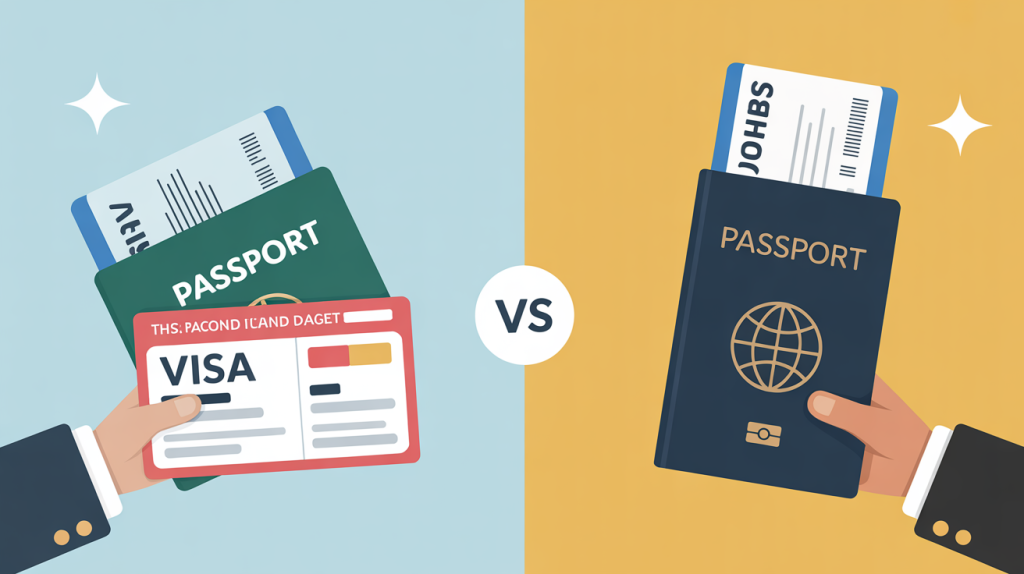Understanding the difference between visa and passport is crucial for anyone planning international travel. Although both documents are essential, they serve entirely different purposes in the travel and immigration process. This guide will help you distinguish their roles, usage, and why both are often required when crossing borders.

Content
Difference Between Visa and Passport: Definitions That Matter
A passport is an official government-issued document that identifies you as a citizen or national of a specific country. It acts as your primary form of international identification and is required to enter or exit most countries.
A visa, on the other hand, is an endorsement placed within your passport by the country you wish to visit. It grants you permission to enter, stay, or transit through that country for a specific purpose and period.
What Is a Passport and Why Is It Required?
A passport confirms your identity and nationality. It contains vital personal information such as your full name, date of birth, photograph, and signature, making it a universal identification tool for international travel.
Most passports fall into a few common types:
- Ordinary/Regular Passport – Used for standard travel purposes like tourism or business.
- Diplomatic Passport – Issued to government officials or diplomats for official international duties.
- Official Passport – Used by government employees traveling for service-related tasks.
- Emergency Passport – Issued in special circumstances, such as a lost or stolen passport abroad.
The difference between visa and passport begins with issuance: while a passport is given by your own country, a visa is granted by the country you plan to visit.
What Is a Visa and When Do You Need It?
A visa is essentially an entry permit. Whether it comes as a sticker, stamp, or digital document, it outlines the reason for your visit—such as tourism, study, work, or medical treatment—and the length of time you are allowed to remain.
Types of visas include:
- Tourist Visa – For leisure and sightseeing.
- Student Visa – For academic pursuits abroad.
- Work Visa – For temporary employment or assignments.
- Transit Visa – For passing through a country en route to another.
- Business Visa – For commercial visits or professional engagements.
What makes the difference between visa and passport more distinct is that not everyone needs a visa to travel. Many countries have visa waiver agreements in place depending on your passport’s country of origin.
Visa vs Passport: A Clear Comparison
To understand the difference between visa and passport at a glance, here’s a direct comparison:

| Attribute | Passport | Visa |
| Issued By | Government of your home country | Government of destination country |
| Purpose | Identity and nationality verification | Permission to enter or stay in a country |
| Validity Duration | Usually 5 to 10 years | Varies from a few days to several years |
| Usage Requirement | Mandatory for international travel | Required based on destination and purpose |
| Form | Booklet with pages | Stamp, sticker, or electronic approval |
This chart helps illustrate the functional difference between visa and passport, especially when planning travel across different regions with varying entry policies.
When Do You Need Both a Visa and a Passport?
In most international travel scenarios, you need both. A passport proves who you are and where you’re from, while a visa proves that you’ve been allowed entry by the destination country. For example:
- A student going to the UK must carry a passport and a student visa.
- A tourist visiting Canada may need a passport and an Electronic Travel Authorization (eTA) depending on nationality.
- A professional relocating for work to a country like Australia will need a valid passport and work visa.
The difference between visa and passport is not just bureaucratic—it’s essential to understanding legal compliance during your travels.
Understanding Cost, Processing Time, and Validity
Another important difference between visa and passport lies in their processing procedures. A passport usually takes longer to acquire initially but remains valid for several years. A visa, however, is generally granted for a specific trip, purpose, or time frame and can be approved faster, depending on the country.
Cost also varies:
- A passport involves a standard government fee, sometimes with additional charges for expedited services.
- A visa’s cost depends on type, urgency, and country-specific policies.
Some visas, like a Schengen or U.S. visa, involve rigorous application procedures including interviews and documentation, further emphasizing the practical difference between visa and passport in international mobility.
Real-World Examples: Country-Specific Visa and Passport Needs
Here are a few destination-specific examples to demonstrate when and how the difference between visa and passport becomes important:
- United States Travel: U.S. citizens need only a passport to travel abroad. Visitors to the U.S. from most countries must have a valid visa or use the Visa Waiver Program.
- Schengen Zone Entry: European passport holders can travel freely, while most non-European travelers must obtain a Schengen visa.
- Canada Travel: Many nationals require both a passport and a visa or eTA.
Understanding each country’s entry policy is crucial. The exact difference between visa and passport will often dictate the documents you must prepare before departure.
Final Thoughts on the Difference Between Visa and Passport
The difference between visa and passport lies in function, issuance, and purpose. One identifies you to the world, while the other grants you access to a specific country. Traveling internationally without understanding this distinction can result in delays, denied boarding, or even deportation.
Before booking any international journey, make sure both your passport and visa (if required) are valid, accurate, and approved. Being informed can make all the difference between a smooth journey and an unnecessary setback. For more information visit our website Traveler tip
FAQs
What is the difference between a visa and a passport?
The difference between visa and passport lies in their function: a passport is a travel document that proves your identity and nationality, while a visa grants you permission to enter a specific country for a defined purpose and duration.
How to ask questions about visas?
To understand the difference between visa and passport or learn visa-specific rules, you can ask clear, direct questions such as: “What type of visa do I need for my trip?” or “How long is my visa valid?” These help clarify requirements based on destination and travel purpose.
What is more important, a visa or a passport?
When considering the difference between visa and passport, neither is more important than the other. A passport is essential for international identity, while a visa is equally important when required by the country you plan to visit. Both are often necessary together.
What is the purpose of a visa?
In the context of the difference between visa and passport, a visa serves as official authorization from a foreign government allowing you to enter, stay, or transit through their country legally for specific reasons like tourism, study, or work.

Nelle Diamond has been to over 100 countries, has a penchant for all things food, and is also an experienced mountaineer. She loves nothing more than exploring the world on her own terms.

